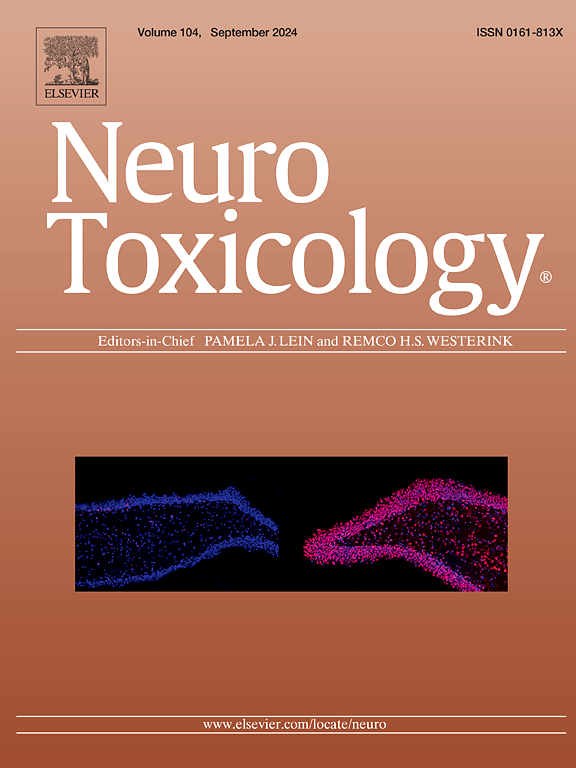β-Caryophyllene attenuates cadmium induced neurotoxicity in rats by modulating different cellular signaling pathways
IF 3.9
3区 医学
Q2 NEUROSCIENCES
引用次数: 0
Abstract
Cadmium (Cd) is a naturally occurring harmful metal that can cause damage to many different tissues and organs in the body. Antioxidant agents are frequently utilized to counteract the harmful impact of this heavy metal on the body. This research explores the neuroprotective role of β-caryophyllene (BCP) in Cd-induced toxicity. Male Wistar rats were categorized into five groups: control, BCP400, Cd, BCP200 +Cd, and BCP400 +Cd. BCP suppressed Cd-induced oxidative damage in brain tissue by regulating the Nrf2/HO-1/SIRT1 signaling pathway. Moreover, BCP alleviates Cd-induced behavioral alterations through SIRT1 activation. Cd increased TNF-α and IL-1β levels and decreased IL-10 levels in brain tissue, whereas BCP suppressed TLR-4/NF-κB/JNK signaling pathway and restored these cytokines to normal levels. In addition, Cd exposure led to increased BAX and Caspase 3 and decreased Bcl-2 levels in neurons, but these proteins approached normal levels thanks to BCP's anti-apoptotic properties. Furthermore, while Beclin-1 and LC3A/B expression levels were increased in neurons of Cd-exposed animals, BCP suppressed these expressions by activating the PI3K/Akt/mTOR signaling pathway. Histopathological, biochemical, and molecular analyses confirmed BCP reduces oxidative stress, inflammation, apoptosis, and autophagy caused by Cd-induced neurotoxicity by regulating various signaling pathways and strengthening the antioxidant defense system. Therefore, we believe that BCP has a high potential as a therapeutic agent against Cd-induced neurotoxicity.
β-石竹烯通过调节不同的细胞信号通路减轻镉诱导的大鼠神经毒性
镉(Cd)是一种天然存在的有害金属,会对人体许多不同的组织和器官造成损害。抗氧化剂经常被用来抵消这种重金属对身体的有害影响。本研究探讨了β-石竹烯(BCP)在cd中毒中的神经保护作用。雄性Wistar大鼠分为5组:对照组、BCP400、Cd、BCP200 +Cd和BCP400 +Cd。BCP通过调控Nrf2/HO-1/SIRT1信号通路抑制cd诱导的脑组织氧化损伤。此外,BCP通过激活SIRT1减轻cd诱导的行为改变。Cd升高脑组织TNF-α和IL-1β水平,降低IL-10水平,而BCP抑制TLR-4/NF-κB/JNK信号通路,使这些细胞因子恢复正常水平。此外,Cd暴露导致神经元中BAX和Caspase 3水平升高,Bcl-2水平降低,但由于BCP的抗凋亡特性,这些蛋白接近正常水平。此外,虽然cd暴露动物神经元中Beclin-1和LC3A/B的表达水平升高,但BCP通过激活PI3K/Akt/mTOR信号通路抑制了这些表达。组织病理学、生化和分子分析证实,BCP通过调节各种信号通路和增强抗氧化防御系统,减少cd诱导的神经毒性引起的氧化应激、炎症、细胞凋亡和自噬。因此,我们认为BCP作为一种治疗cd诱导的神经毒性的药物具有很高的潜力。
本文章由计算机程序翻译,如有差异,请以英文原文为准。
求助全文
约1分钟内获得全文
求助全文
来源期刊

Neurotoxicology
医学-毒理学
CiteScore
6.80
自引率
5.90%
发文量
161
审稿时长
70 days
期刊介绍:
NeuroToxicology specializes in publishing the best peer-reviewed original research papers dealing with the effects of toxic substances on the nervous system of humans and experimental animals of all ages. The Journal emphasizes papers dealing with the neurotoxic effects of environmentally significant chemical hazards, manufactured drugs and naturally occurring compounds.
 求助内容:
求助内容: 应助结果提醒方式:
应助结果提醒方式:


